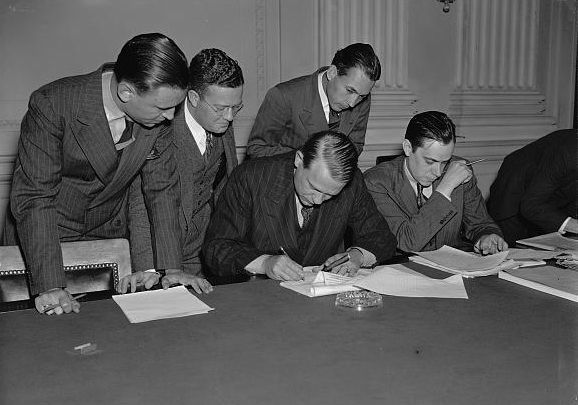You're talking about the Rosenbergs in 1943.
Way more than just them.
...
The decrypted messages gave important insights into Soviet behavior in the period during which duplicate one-time pads were used. With the first break into the code, Venona revealed the existence of Soviet espionage
[24] at
Los Alamos National Laboratories.
[25] Identities soon emerged of American, Canadian, Australian, and British spies in service to the Soviet government, including
Klaus Fuchs,
Alan Nunn May, and
Donald Maclean. Others worked in Washington in the
State Department, the Treasury,
Office of Strategic Services,
[26] and even the White House.
The messages show that the U.S. and other nations were targeted in major espionage campaigns by the Soviet Union as early as 1942. Among those identified are
Julius and Ethel Rosenberg;
Alger Hiss;
Harry Dexter White, the second-highest official in the Treasury Department;
Lauchlin Currie,
[27] a personal aide to Franklin Roosevelt; and
Maurice Halperin,
[28] a section head in the Office of Strategic Services.
The identification of individuals mentioned in Venona transcripts is sometimes problematic, since people with a "covert relationship" with Soviet intelligence are referenced by cryptonyms.
[29] Further complicating matters is the fact the same person sometimes had different cryptonyms at different times, and the same cryptonym was sometimes reused for different individuals. In some cases, notably Hiss, the matching of a Venona cryptonym to an individual is disputed. In many other cases, a Venona cryptonym has not yet been linked to any person. According to authors
John Earl Haynes and
Harvey Klehr, the Venona transcripts identify approximately 349 Americans who they claim had a covert relationship with Soviet intelligence, though fewer than half of these have been matched to real-name identities.
[30] However, not every agent may have been communicating directly with Soviet intelligence. Each of those 349 persons may have had many others working for, and reporting only to, them.
The
Office of Strategic Services, the predecessor to the
CIA, housed at one time or another between fifteen and twenty Soviet spies.
[31] Duncan Lee,
Donald Wheeler,
Jane Foster Zlatowski, and
Maurice Halperin passed information to Moscow. The
War Production Board, the
Board of Economic Warfare, the
Office of the Coordinator of Inter-American Affairs and the
Office of War Information, included at least half a dozen Soviet sources each among their employees.
...

en.wikipedia.org
~~~~~~~~~~~~~
Also;
More than 60 years have passed since the end of World War II, and only now is some once-secret information from that conflict coming to light. It is not

www.historynet.com

